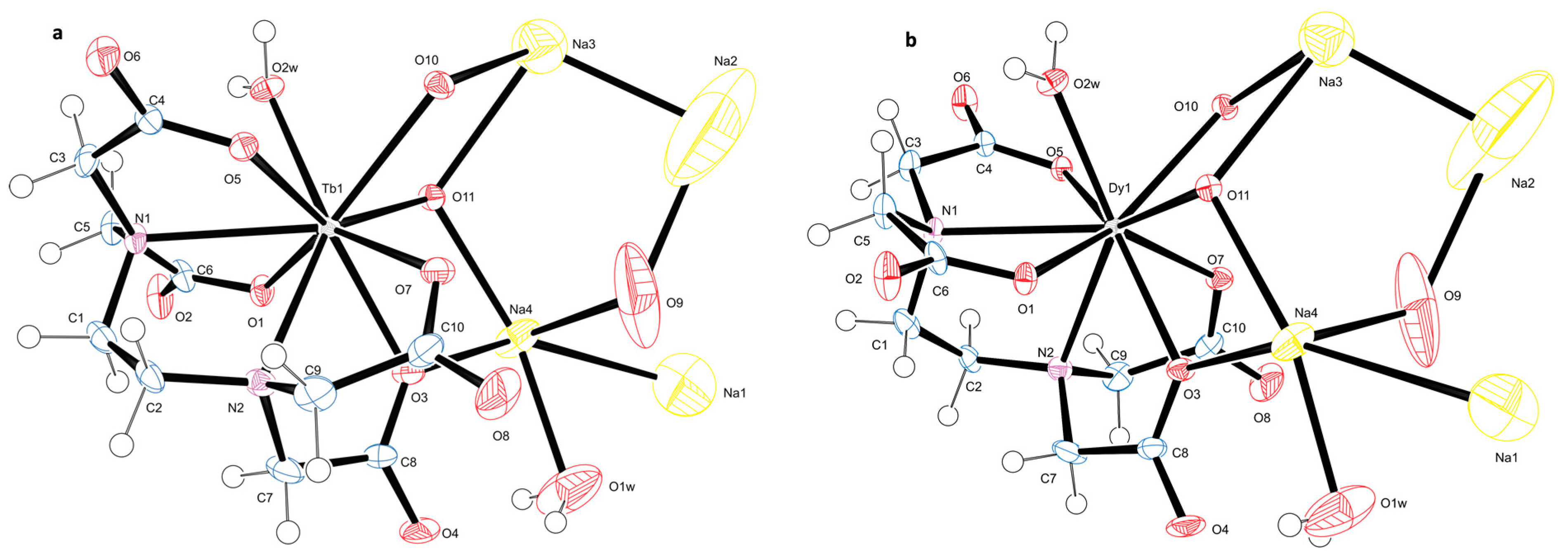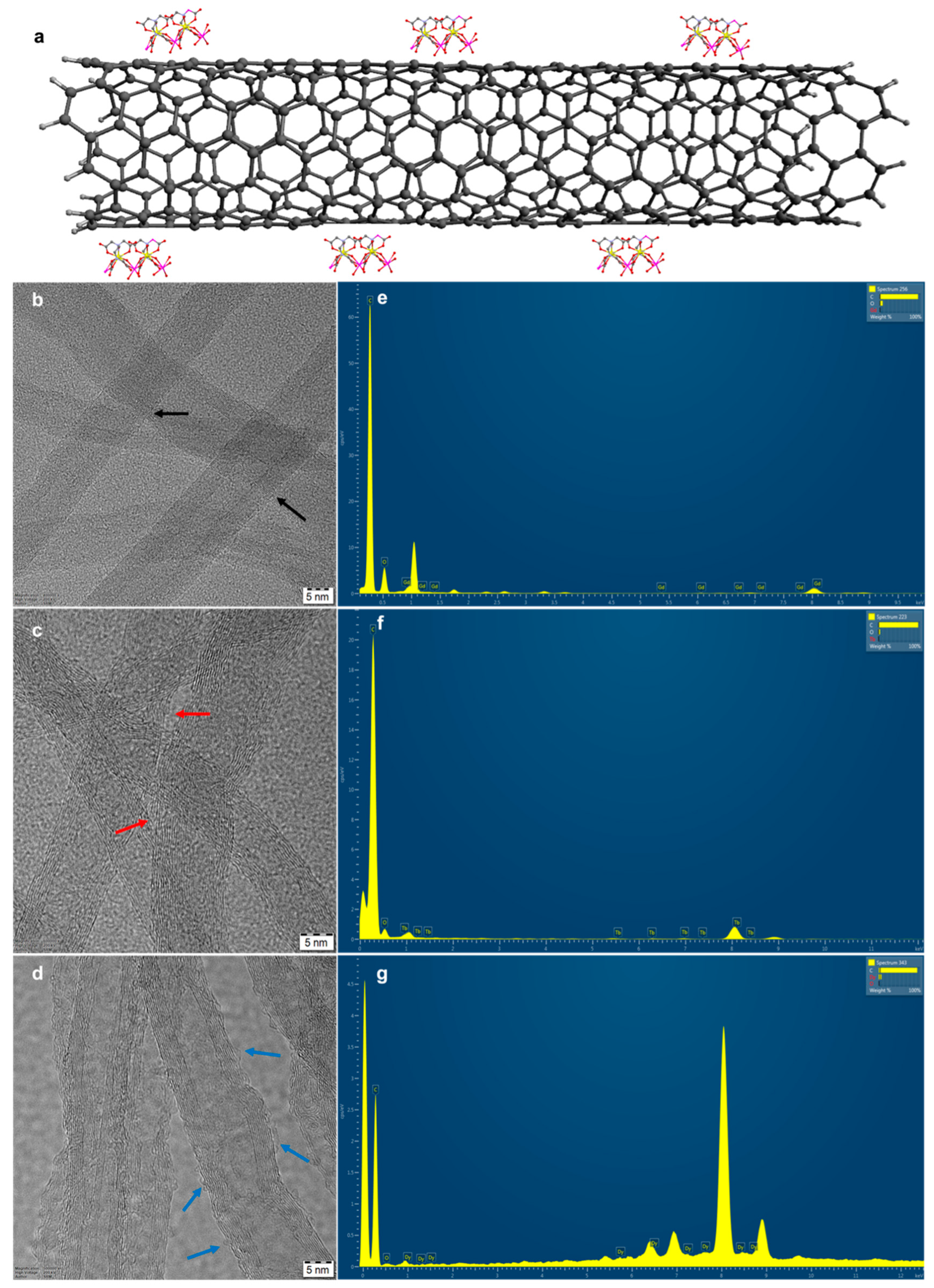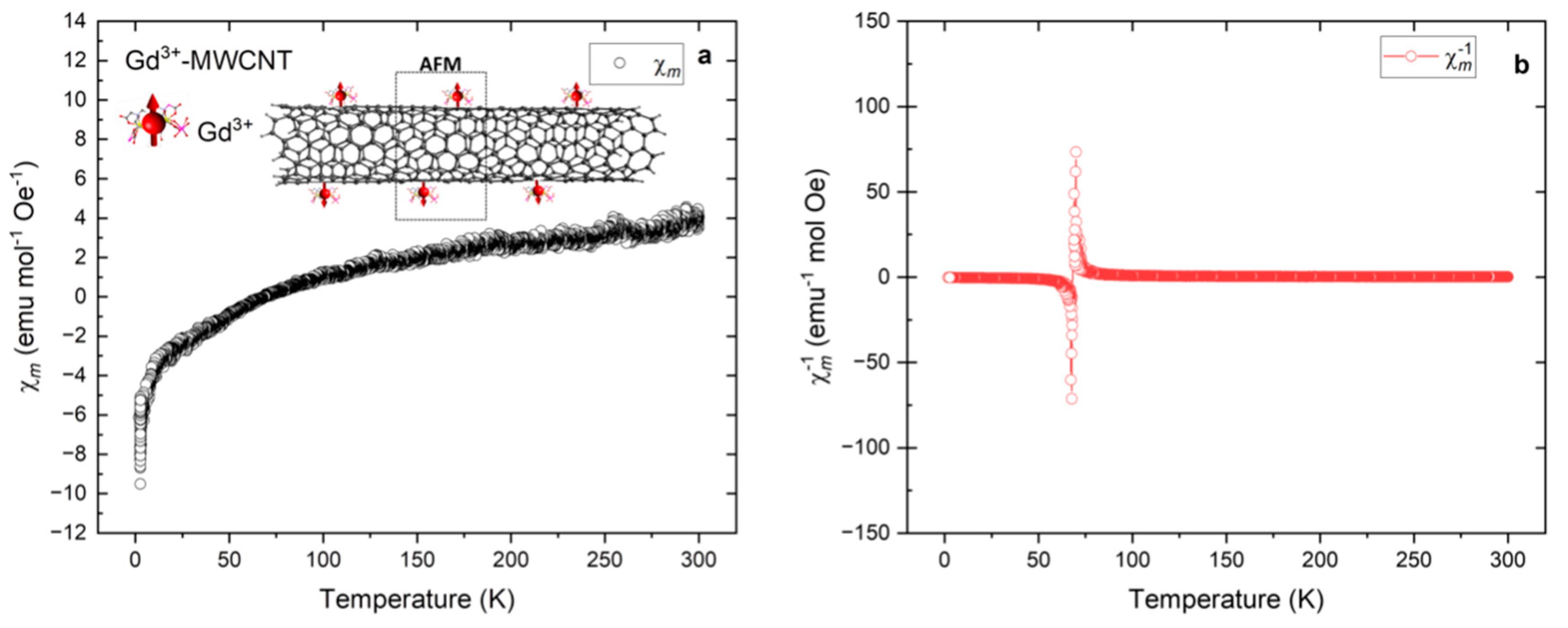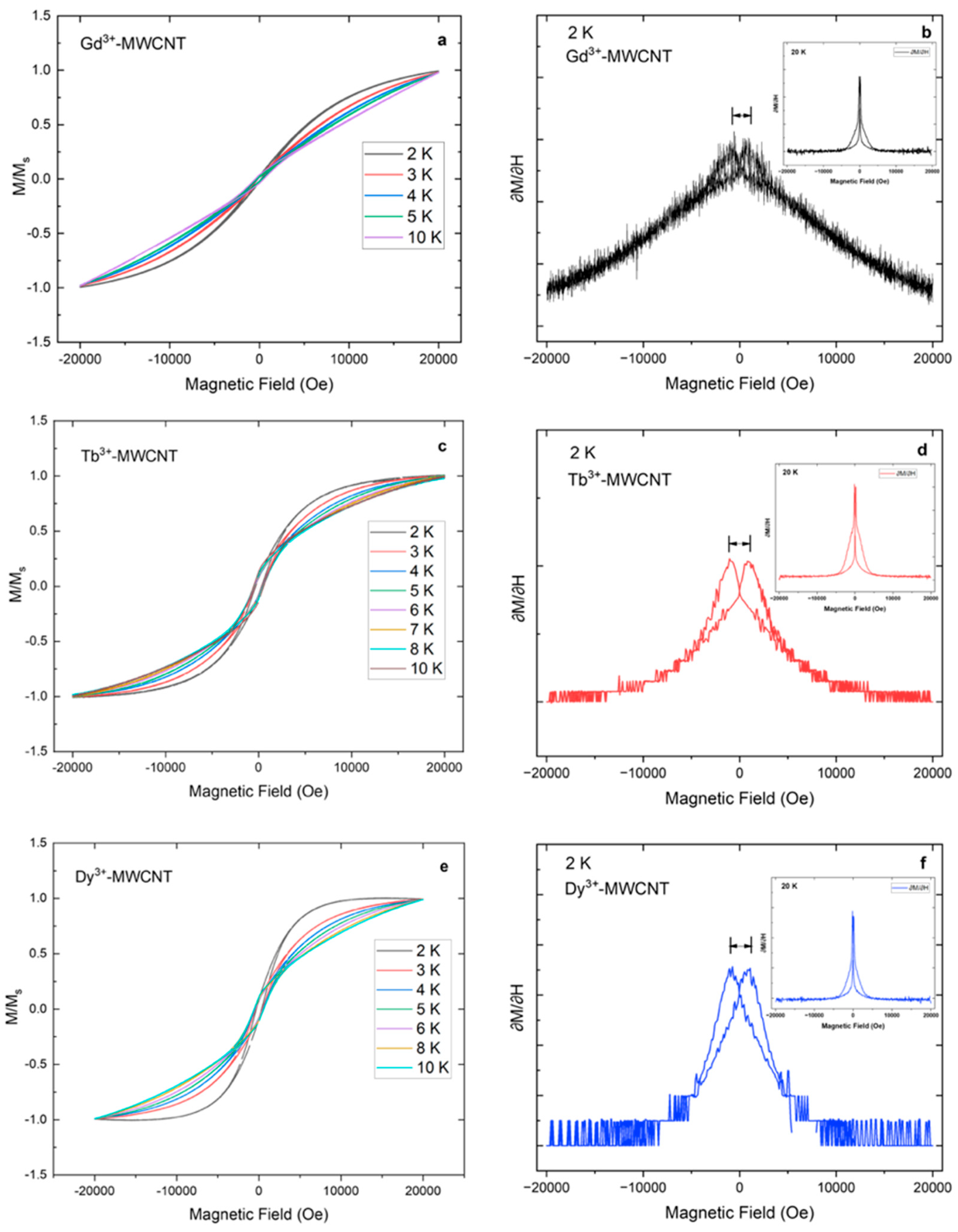Observation of High Magnetic Bistability in Lanthanide (Ln = Gd, Tb and Dy)-Grafted Carbon Nanotube Hybrid Molecular System
Abstract
:1. Introduction
2. Results
2.1. Crystal Structure Description
2.2. Grafting Ln-EDTA SMMs onto Carbon Nanotubes
2.3. Magnetization Studies of Ln-EDTA-Grafted CNT Molecular System
3. Discussion
4. Materials, Methods and Instrumentation
4.1. Ln–EDTA Chelate Synthesis
4.2. Ln–EDTA Grafting onto MWCNTs
4.3. HR–TEM and EDAX
4.4. Single-Crystal X-ray Diffraction
4.5. DC PPMS Magnetometry
5. Conclusions
Supplementary Materials
Author Contributions
Funding
Institutional Review Board Statement
Informed Consent Statement
Data Availability Statement
Acknowledgments
Conflicts of Interest
References
- Woodruff, D.N.; Winpenny, R.E.P.; Layfield, R.A. Lanthanide Single-Molecule Magnets. Chem. Rev. 2013, 113, 5110–5148. [Google Scholar] [CrossRef]
- Schenker, R.; Leuenberger, M.N.; Gregory, C.; Güdel, H.U.; Loss, D. Butterfly Hysteresis and Slow Relaxation of the Magnetization in (Et4 N)3 Fe2 F9: Manifestations of a Single-Molecule Magnet. Chem. Phys. Lett. 2002, 358, 413–418. [Google Scholar] [CrossRef] [Green Version]
- Ishikawa, N.; Sugita, M.; Wernsdorfer, W. Quantum Tunneling of Magnetization in Lanthanide Single-Molecule Magnets: Bis(Phthalocyaninato)Terbium and Bis(Phthalocyaninato)Dysprosium Anions. Angew. Chem.—Int. Ed. 2005, 44, 2931–2935. [Google Scholar] [CrossRef] [Green Version]
- Thomas, L.; Lionti, F.; Ballou, R.; Gatteschi, D.; Barbara, B. Macroscopic Quantum Tunnelling of Magnetization in a Single Crystal of Nanomagnets. Nature 1996, 383, 145–147. [Google Scholar] [CrossRef]
- Mannini, M.; Pineider, F.; Danieli, C.; Totti, F.; Sorace, L.; Sainctavit, P.; Arrio, M.A.; Otero, E.; Joly, L.; Cezar, J.C.; et al. Quantum Tunnelling of the Magnetization in a Monolayer of Oriented Single-Molecule Magnets. Nature 2010, 468, 417–421. [Google Scholar] [CrossRef]
- Wernsdorfer, W.; Soler, M.; Christou, G.; Hendrickson, D.N. Quantum Phase Interference (Berry Phase) in Single-Molecule Magnets of [Mn12]2−. J. Appl. Phys. 2002, 91, 7164–7166. [Google Scholar] [CrossRef]
- Gaita-Ariño, A.; Luis, F.; Hill, S.; Coronado, E. Molecular Spins for Quantum Computation. Nat. Chem. 2019, 11, 301–309. [Google Scholar] [CrossRef]
- Mannini, M.; Pineider, F.; Sainctavit, P.; Danieli, C.; Otero, E.; Sciancalepore, C.; Talarico, A.M.; Arrio, M.A.; Cornia, A.; Gatteschi, D.; et al. Magnetic Memory of a Single-Molecule Quantum Magnet Wired to a Gold Surface. Nat. Mater. 2009, 8, 194–197. [Google Scholar] [CrossRef]
- Ardavan, A.; Rival, O.; Morton, J.J.L.; Blundell, S.J.; Tyryshkin, A.M.; Timco, G.A.; Winpenny, R.E.P. Will Spin-Relaxation Times in Molecular Magnets Permit Quantum Information Processing? Phys. Rev. Lett. 2007, 98, 057201. [Google Scholar] [CrossRef] [Green Version]
- Urdampilleta, M.; Klyatskaya, S.; Cleuziou, J.P.; Ruben, M.; Wernsdorfer, W. Supramolecular Spin Valves. Nat. Mater. 2011, 10, 502–506. [Google Scholar] [CrossRef]
- Chilton, N.F. Design Criteria for High-Temperature Single-Molecule Magnets. Inorg. Chem. 2015, 54, 2097–2099. [Google Scholar] [CrossRef]
- Wu, H.; Li, M.; Xia, Z.; Montigaud, V.; Cador, O.; Le Guennic, B.; Ke, H.; Wang, W.; Xie, G.; Chen, S.; et al. High Temperature Quantum Tunnelling of Magnetization and Thousand Kelvin Anisotropy Barrier in a Dy2single-Molecule Magnet. Chem. Commun. 2021, 57, 371–374. [Google Scholar] [CrossRef]
- Sessoli, R.; Tsai, H.-L.; Schake, A.R.; Wang, S.; Vincent, J.B.; Foiling, K.; Gatteschi, D.; Christou, G.; Hendrickson, D.N. High-Spin Molecules: [Mn12012(02CR)16(H20)4]. J. Am. Chem. Soc. 1993, 115, 1804–1816. [Google Scholar] [CrossRef]
- Sessoli, R.; Gatteschi, D.; Caneschi, A.; Novak, M.A. Magnetic Bistability in a Metal-Ion Cluster. Nature 1993, 365, 141–143. [Google Scholar] [CrossRef]
- Meng, Y.S.; Da Jiang, S.; Wang, B.W.; Gao, S. Understanding the Magnetic Anisotropy toward Single-Ion Magnets. Acc. Chem. Res. 2016, 49, 2381–2389. [Google Scholar] [CrossRef]
- Cirera, J.; Ruiz, E.; Alvarez, S.; Neese, F.; Kortus, J. How to Build Molecules with Large Magnetic Anisotropy. Chemistry 2009, 15, 4078–4087. [Google Scholar] [CrossRef]
- Yang, W.; Velkos, G.; Liu, F.; Sudarkova, S.M.; Wang, Y.; Zhuang, J.; Zhang, H.; Li, X.; Zhang, X.; Büchner, B.; et al. Single Molecule Magnetism with Strong Magnetic Anisotropy and Enhanced Dy∙∙∙Dy Coupling in Three Isomers of Dy-Oxide Clusterfullerene Dy2O@C82. Adv. Sci. 2019, 6. [Google Scholar] [CrossRef] [Green Version]
- Novitchi, G.; Costes, J.P.; Tuchagues, J.P.; Vendier, L.; Wernsdorfer, W. A Single Molecule Magnet (SMM) with a Helicate Structure. New J. Chem. 2008, 32, 197–200. [Google Scholar] [CrossRef]
- Kostanyan, A.; Schlesier, C.; Westerström, R.; Dreiser, J.; Fritz, F.; Büchner, B.; Popov, A.A.; Piamonteze, C.; Greber, T. Gadolinium as an Accelerator for Reaching Thermal Equilibrium and Its Influence on the Ground State of Dy2GdN@ C80 Single-Molecule Magnets. Phys. Rev. B 2021, 103, 014404. [Google Scholar] [CrossRef]
- Woodruff, D.N.; Tuna, F.; Bodensteiner, M.; Winpenny, R.E.P.; Layfield, R.A. Single-Molecule Magnetism in Tetrametallic Terbium and Dysprosium Thiolate Cages. Organometallics 2013, 32, 1224–1229. [Google Scholar] [CrossRef]
- Bogani, L.; Danieli, C.; Biavardi, E.; Bendiab, N.; Barra, A.L.; Dalcanale, E.; Wernsdorfer, W.; Cornia, A. Single-Molecule-Magnet Carbon-Nanotube Hybrids. Angew. Chem.—Int. Ed. 2009, 48, 746–750. [Google Scholar] [CrossRef] [PubMed]
- Kyatskaya, S.; Mascarós, J.R.G.; Bogani, L.; Hennrich, F.; Kappes, M.; Wernsdorfer, W.; Ruben, M. Anchoring of Rare-Earth-Based Single-Molecule Magnets on Single-Walled Carbon Nanotubes. J. Am. Chem. Soc. 2009, 131, 15143–15151. [Google Scholar] [CrossRef] [PubMed]
- Moreno-Da Silva, S.; Martínez, J.I.; Develioglu, A.; Nieto-Ortega, B.; De Juan-Fernández, L.; Ruiz-Gonzalez, L.; Picón, A.; Oberli, S.; Alonso, P.J.; Moonshiram, D.; et al. Magnetic, Mechanically Interlocked Porphyrin-Carbon Nanotubes for Quantum Computation and Spintronics. J. Am. Chem. Soc. 2021, 143, 21286–21293. [Google Scholar] [CrossRef] [PubMed]
- Urdampilleta, M.; Nguyen, N.V.; Cleuziou, J.P.; Klyatskaya, S.; Ruben, M.; Wernsdorfer, W. Molecular Quantum Spintronics: Supramolecular Spin Valves Based on Single-Molecule Magnets and Carbon Nanotubes. Int. J. Mol. Sci. 2011, 12, 6656–6667. [Google Scholar] [CrossRef] [PubMed]
- Ncube, S.; Coleman, C.; Strydom, A.; Flahaut, E.; De Sousa, A.; Bhattacharyya, S. Kondo Effect and Enhanced Magnetic Properties in Gadolinium Functionalized Carbon Nanotube Supramolecular Complex. Sci. Rep. 2018, 8, 8057. [Google Scholar] [CrossRef] [Green Version]
- Krainov, I.V.; Klier, J.; Dmitriev, A.P.; Klyatskaya, S.; Ruben, M.; Wernsdorfer, W.; Gornyi, I.V. Giant Magnetoresistance in Carbon Nanotubes with Single-Molecule Magnets TbPc2. ACS Nano 2017, 11, 6868–6880. [Google Scholar] [CrossRef]
- Luis, F.; Repollés, A.; Martínez-Pérez, M.J.; Aguilà, D.; Roubeau, O.; Zueco, D.; Alonso, P.J.; Evangelisti, M.; Camón, A.; Sesé, J.; et al. Molecular Prototypes for Spin-Based CNOT and SWAP Quantum Gates. Phys. Rev. Lett. 2011, 107, 117203. [Google Scholar] [CrossRef] [Green Version]
- Martínez-Pérez, M.J.; Cardona-Serra, S.; Schlegel, C.; Moro, F.; Alonso, P.J.; Prima-García, H.; Clemente-Juan, J.M.; Evangelisti, M.; Gaita-Ariño, A.; Sesé, J.; et al. Gd-Based Single-Ion Magnets with Tunable Magnetic Anisotropy: Molecular Design of Spin Qubits. Phys. Rev. Lett. 2012, 108, 247213. [Google Scholar] [CrossRef] [Green Version]
- Bogani, L.; Wernsdorfer, W. Molecular Spintronics Using Single-Molecule Magnets. Nat. Mater. 2008, 7, 179–186. [Google Scholar] [CrossRef]
- Chen, J.S.; Trerayapiwat, K.J.; Sun, L.; Krzyaniak, M.D.; Wasielewski, M.R.; Rajh, T.; Sharifzadeh, S.; Ma, X. Long-Lived Electronic Spin Qubits in Single-Walled Carbon Nanotubes. Nat. Commun. 2023, 14, 848. [Google Scholar] [CrossRef]
- Yin, X.; Deng, L.; Ruan, L.; Wu, Y.; Luo, F.; Qin, G.; Han, X.; Zhang, X. Recent Progress for Single-Molecule Magnets Based on Rare Earth Elements. Materials 2023, 16, 3568. [Google Scholar] [CrossRef]
- Mosse, I.S.; Sodisetti, V.R.; Coleman, C.; Ncube, S.; de Sousa, A.S.; Erasmus, R.M.; Flahaut, E.; Blon, T.; Lassagne, B.; Šamořil, T.; et al. Tuning Magnetic Properties of a Carbon Nanotube-Lanthanide Hybrid Molecular Complex through Controlled Functionalization. Molecules 2021, 26, 563. [Google Scholar] [CrossRef]
- Sodisetti, V.R.; Ncube, S.; Coleman, C.; Erasmus, R.M.; Flahaut, E.; Bhattacharyya, S. Strong Spin-Phonon Coupling in Gd-Filled Nanotubes. J. Appl. Phys. 2021, 130. [Google Scholar] [CrossRef]
- Holmberg, R.J.; Ho, L.T.A.; Ungur, L.; Korobkov, I.; Chibotaru, L.F.; Murugesu, M. Observation of Unusual Slow-Relaxation of the Magnetisation in a Gd-EDTA Chelate. Dalton Trans. 2015, 44, 20321–20325. [Google Scholar] [CrossRef] [PubMed]
- Holmberg, R.J.; Korobkov, I.; Murugesu, M. Enchaining EDTA-Chelated Lanthanide Molecular Magnets into Ordered 1D Networks. RSC Adv. 2016, 6, 72510–72518. [Google Scholar] [CrossRef]
- De Oliveira Maciel, J.W.; Lemes, M.A.; Valdo, A.K.; Rabelo, R.; Martins, F.T.; Queiroz Maia, L.J.; De Santana, R.C.; Lloret, F.; Julve, M.; Cangussu, D. Europium(III), Terbium(III), and Gadolinium(III) Oxamato-Based Coordination Polymers: Visible Luminescence and Slow Magnetic Relaxation. Inorg. Chem. 2021, 60, 6176–6190. [Google Scholar] [CrossRef]
- Ing, X.-L.; Hai, Y.-Q.; Han, T.; Chen, W.E.-P.; Ding, Y.-S.; Heng, Y.-Z. ALocal D 4h Symmetric Dysprosium(III) Single-Molecule Magnet with an Energy Barrier Exceeding 2000 K**. Chemistry 2021, 27, 2623–2627. [Google Scholar] [CrossRef]
- Hart, J.R. Ethylenediaminetetraacetic Acid and Related Chelating Agents. In Ullmann’s Encyclopedia of Industrial Chemistry; Wiley-VCH Verlag GmbH & Co. KGaA: Weinheim, Germany, 2011. [Google Scholar]
- Marangon, I.; Ménard-Moyon, C.; Kolosnjaj-Tabi, J.; Béoutis, M.L.; Lartigue, L.; Alloyeau, D.; Pach, E.; Ballesteros, B.; Autret, G.; Ninjbadgar, T.; et al. Covalent Functionalization of Multi-Walled Carbon Nanotubes with a Gadolinium Chelate for Efficient T1-Weighted Magnetic Resonance Imaging. Adv. Funct. Mater. 2014, 24, 7173–7186. [Google Scholar] [CrossRef]
- Smerat, S.; Schoeller, H.; McCulloch, I.P.; Schollwöck, U. Coulomb Interaction Effects and Electron Spin Relaxation in the One-Dimensional Kondo Lattice Model. Phys. Rev. B Condens. Matter Mater. Phys. 2011, 83, 085111. [Google Scholar] [CrossRef] [Green Version]
- He, B.; Sun, W.; Wang, M.; Shen, Z. New Magnetic Phenomena of Rare Earth Ions-Modified Carbon Nanotubes. Mater. Chem. Phys. 2006, 95, 202–205. [Google Scholar] [CrossRef]
- Proenca, M.P.; Sousa, C.T.; Ventura, J.; Araújo, J.P. Electrochemical Synthesis and Magnetism of Magnetic Nanotubes. In Magnetic Nano- and Microwires: Design, Synthesis, Properties and Applications; Elsevier: Amsterdam, The Netherlands, 2015; pp. 727–781. ISBN 9780081001646. [Google Scholar]
- Escrig, J.; Bachmann, J.; Jing, J.; Daub, M.; Altbir, D.; Nielsch, K. Crossover between Two Different Magnetization Reversal Modes in Arrays of Iron Oxide Nanotubes. Phys. Rev. B Condens. Matter Mater. Phys. 2008, 77, 214421. [Google Scholar] [CrossRef] [Green Version]
- Albrecht, O.; Zierold, R.; Allende, S.; Escrig, J.; Patzig, C.; Rauschenbach, B.; Nielsch, K.; Görlitz, D. Experimental Evidence for an Angular Dependent Transition of Magnetization Reversal Modes in Magnetic Nanotubes. J. Appl. Phys. 2011, 109, 093910. [Google Scholar] [CrossRef]
- Gatteschi, D.; Sessoli, R.; Villain, J. Molecular Nanomagnets; Oxford University Press: Oxford, UK, 2006. [Google Scholar]
- Sharma, M.P.; Johnson, L.G.; Mcclure, J.W. Diamagnetism of Graphite. Phys. Rev. B 1974, 104, 666. [Google Scholar] [CrossRef] [Green Version]
- Kotosonov, A.S.; Kuvshinnikov, S.V. Diamagnetism of Some Quasi-Two-Dimensional and Multiwall Carbon Nanotubes. Phys. Lett. A 1997, 229, 377–380. [Google Scholar] [CrossRef]
- Elser, V.; Haddon, R.C. Icosahedral C60- an Aromatic Molecule with a Vanishingly Small Ring Current Magnetic Susceptibility. Nature 1987, 325, 792–794. [Google Scholar] [CrossRef]
- Ling, M.F.; Finlayson, T.R.; Raston, C.L. Nonlinear Field-Dependent Susceptibilities of C60 and Carbon Nanotubes. Aust. J. Phys. 1999, 52, 913–918. [Google Scholar] [CrossRef] [Green Version]
- Han, T.; Gansiracusa, M.J.; Li, Z.-H.; DIng, Y.-S.; Chilton, N.F.; Winpenny, R.E.P.; Heng, Y.-Z. Exchange-Biasing in a Dinuclear Dysprosium(III) Single-Molecule Magnet with a Large Energy Barrier for Magnetisation Reversal. Chemistry 2020, 26, 6773–6777. [Google Scholar] [CrossRef]
- Katoh, K.; Sato, J.; Nakanishi, R.; Ara, F.; Komeda, T.; Kuwahara, Y.; Saito, T.; Breedlove, B.K.; Yamashita, M. Terbium(III) Bis-Phthalocyaninato Single-Molecule Magnet Encapsulated in a Single-Walled Carbon Nanotube. J. Mater. Chem. C Mater. 2021, 9, 10697–10704. [Google Scholar] [CrossRef]
- Hymas, K.; Soncini, A. Origin of the Hysteresis of Magnetoconductance in a Supramolecular Spin-Valve Based on a TbPc2 Single-Molecule Magnet. Phys. Rev. B 2020, 102, 125310. [Google Scholar] [CrossRef]






| Tb-EDTA | Dy-EDTA | |
|---|---|---|
| Formula | C10H16TbN2Na4O13 | C10H16DyN2Na4O13 |
| Mr | 623.13 | 626.71 |
| Temperature/°C | −100 | −100 |
| Crystal size/mm | 0.684 × 0.502 × 0.487 | 0.549 × 0.393 × 0.188 |
| Crystal system | Orthorhombic | orthorhombic |
| Space group (no.) | Fdd2 | Fdd2 |
| a/Å | 19.3067 (11) | 19.3107 (18) |
| b/Å | 35.1670 (19) | 35.216 (3) |
| c/Å | 12.0522 (6) | 12.0558 (11) |
| V/Å3 | 8182.9 (8) | 8198.6 (13) |
| Z | 16 | 16 |
| Dc/g cm−3 | 2.028 | 2.031 |
| μ (Mo-Kα)/mm−1 | 3.608 | 3.796 |
| Theta range/° | 3.134 to 29.999° | 2.641 to 29.996° |
| Total reflections | 55,841 | 44,545 |
| No. unique data | 5936 | 5946 |
| R (int) | 0.0194 | 0.0194 |
| No. data with I > 2σ(I) | 5930 | 5933 |
| final R (I > 2σ(I)) | 0.0230 | 0.0282 |
| final wR2 (all data) | 0.0591 | 0.0677 |
| Restraints/parameters | 1/274 | 1/274 |
| Molecular System | ||||||
|---|---|---|---|---|---|---|
| 2 K | 300 K | 2 K | 300 K | 2 K | 300 K | |
| Gd3+-MWCNT | 250 | 145 | 0.026 | 0.010 | 1.307 | 0.022 |
| Tb3+-MWCNT | 320 | 58 | 0.073 | 0.012 | 0.44 | 0.054 |
| Dy3+-MWCNT | 322 | 65 | 0.084 | 0.011 | 0.27 | 0.025 |
| Rare Earth in Complexes | S | L | J | g | Experimental | |
|---|---|---|---|---|---|---|
| Gd3+ 4fn; n = 7 | 7/2 | 0 | 7/2 | 2.00 | 7.94 | NA |
| Tb3+ 4fn; n = 8 | 3 | 3 | 6 | 1.50 | 9.72 | 12.7279 |
| Dy3+ 4fn; n = 9 | 5/2 | 5 | 15/2 | 1.33 | 10.65 | 10.4859 |
Disclaimer/Publisher’s Note: The statements, opinions and data contained in all publications are solely those of the individual author(s) and contributor(s) and not of MDPI and/or the editor(s). MDPI and/or the editor(s) disclaim responsibility for any injury to people or property resulting from any ideas, methods, instructions or products referred to in the content. |
© 2023 by the authors. Licensee MDPI, Basel, Switzerland. This article is an open access article distributed under the terms and conditions of the Creative Commons Attribution (CC BY) license (https://creativecommons.org/licenses/by/4.0/).
Share and Cite
Sodisetti, V.R.; Lemmerer, A.; Wamwangi, D.; Bhattacharyya, S. Observation of High Magnetic Bistability in Lanthanide (Ln = Gd, Tb and Dy)-Grafted Carbon Nanotube Hybrid Molecular System. Int. J. Mol. Sci. 2023, 24, 12303. https://doi.org/10.3390/ijms241512303
Sodisetti VR, Lemmerer A, Wamwangi D, Bhattacharyya S. Observation of High Magnetic Bistability in Lanthanide (Ln = Gd, Tb and Dy)-Grafted Carbon Nanotube Hybrid Molecular System. International Journal of Molecular Sciences. 2023; 24(15):12303. https://doi.org/10.3390/ijms241512303
Chicago/Turabian StyleSodisetti, Venkateswara Rao, Andreas Lemmerer, Daniel Wamwangi, and Somnath Bhattacharyya. 2023. "Observation of High Magnetic Bistability in Lanthanide (Ln = Gd, Tb and Dy)-Grafted Carbon Nanotube Hybrid Molecular System" International Journal of Molecular Sciences 24, no. 15: 12303. https://doi.org/10.3390/ijms241512303
APA StyleSodisetti, V. R., Lemmerer, A., Wamwangi, D., & Bhattacharyya, S. (2023). Observation of High Magnetic Bistability in Lanthanide (Ln = Gd, Tb and Dy)-Grafted Carbon Nanotube Hybrid Molecular System. International Journal of Molecular Sciences, 24(15), 12303. https://doi.org/10.3390/ijms241512303






